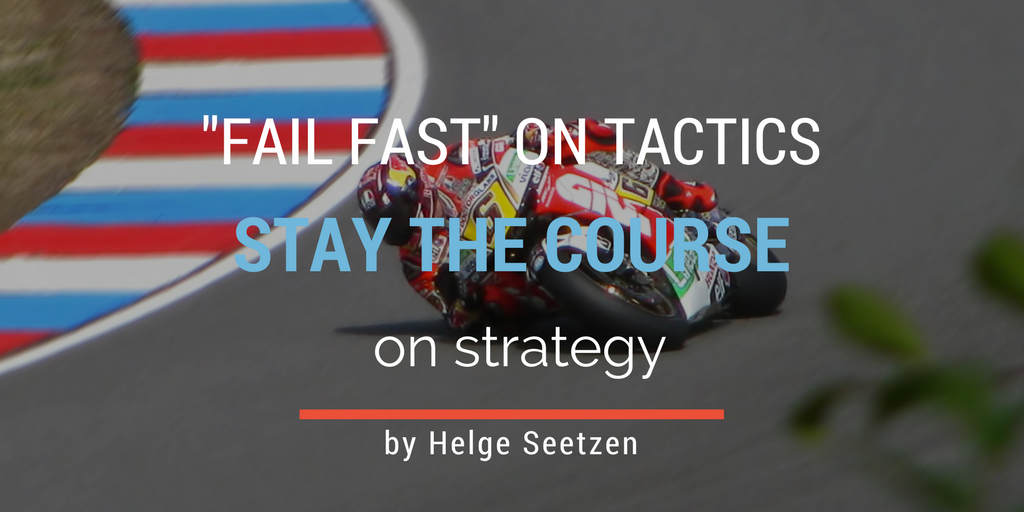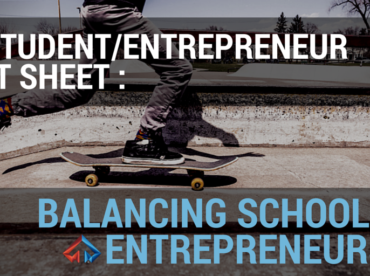This post started as a discussion on Mark Suster’s blog that became far too long. So I thought I make it an even longer blog post…
The nature of my job brings me into frequent contact with entrepreneurs, and the nature of entrepreneurship means that a lot of their ventures have failed. I have observed a recent trend in those meetings: The word “fast” is now often added to the statement “I failed”. Grammatically that’s not a problem and the statement is probably even factually correct. The start-up environment is accelerating so entrepreneurs tend to fail (and succeed) more quickly. What is scary about this new statement is the change in tone.
More often than not, “I failed fast” is now said with a tone of deep satisfaction. Sort of like a puppy that brought the newspaper and is awaiting a pad on the head. What the heck is good about failing? Fast or slow? When did it become fashionable to fail? It took me a while to figure out that “Failing Fast” is one of those new internet buzz words where you can practically hear the capital letters fall into place.
Let me be blunt: Failing is never a good thing! It’s especially bad in the context of a company where you are hurting your employees, customers and investors when you fail. These are human beings who suffer and taking pride in this is nothing but warped hedonism.
This doesn’t mean that failure doesn’t happen to the best of us. We all fail; we all make mistakes, and entrepreneurial ventures fail more often than not. We just shouldn’t be proud of it!
I get the sense that the original (internet) definition of “failing fast” comes out of the product development space. In that context, “failing fast” is just a simplistic description of the Scientific Method: Create a hypothesis, validate it experimentally, and adjust your hypothesis if the result isn’t consistent with the initial prediction.
Scientists have done this for centuries and I suspect that Aristotle would be pretty offended to hear it described as “failing” (don’t jump on Google now, he doesn’t have a blog!). Experiments yield results. Maybe not the result that you were predicting but always results. Getting unanticipated results is good and educational. A failed experiment on the other hand just means that you messed up the design or execution.
Part of the problem here is just semantics. Like many internet buzzwords, “failing fast” doesn’t match up with common English usage of the word “fail” (in the same way that “lean start-up” is often wrongly understood as “slim/low cost” simply because that’s what the word “lean” actually means). This makes the term easy to misunderstand when entrepreneurs take it at face value.
The bigger problem is a lack of distinction between strategy and tactics in the “failing fast” mantra. These are two very different aspects of a venture. Strategy is your prediction of the future and a roadmap to making money in that predicted future (e.g. market dynamics, technology, customer behaviour, etc.). Tactics fill in the pieces in this strategic roadmap (e.g. product features and types, monetization models, operational structures, etc.). Tactics generally benefit from fast iteration, while strategy almost always requires persistence.
Imagine a basic study with two independent variables A and B with 10 possible values each. Finding the right solution will require a series of up to 100 tactical experiments. The main driver of the timeline generally won’t be the length of the experiment but the experimenter’s ability to create bounds for the likely solution space. Tighter (correct) bounds will greatly accelerate the overall project and that’s the purpose of the experimental strategy.
In the real world, all worthwhile problems are massively multi-dimensional and have wide variable ranges. A good strategy reduces the solution space so much that the speed of each experiment becomes a very secondary consideration. That’s why scientists develop models and research the bounds of past studies.
Creating such a strategy for an entrepreneurial venture takes domain experience, research, analytical modeling and, yes, a business plan (though not necessarily the 100 page document write-up thereof). You can’t create it through tactical iteration for the same reasons that you cannot write a novel by randomly combining words – at least not in your lifetime.
Having invested so much into your strategic vision, you shouldn’t change it at the first opportunity. Your strategic vision will receive some negative feedback but there is no reason why getting an unpredicted result in your first experiment on that 100 element matrix should dishearten you. It certainly shouldn’t make you abandon the search or your direction. Doing so would undermine the whole concept of entrepreneurship.
Entrepreneurs make money because they take more risk than other (equally smart) people. So you have to pick a strategic vision that isn’t popular (yet). If everybody already shares your vision today then you are probably not taking a big enough risk to warrant a massive entrepreneurial payout.
At the same time you should of course constantly revise your tactical decisions such as product features, revenue models, customer focus, and so forth. Those are generally operational decisions and not the main value driver of your venture. Doing this quickly, iteratively and as good as you can is better than doing it slowly (or badly). But don’t think for a second that the speed of these tactical iterations will make you successful. That will depend on almost entirely on the validity of your strategic vision.
Take the example of my LED display start-up. The founding predictions (and supporting research) of our venture were that
a) People would like to see digital images with comparable contrast to the real world (I spent 8 months in a neuroscience/psychophysics vision lab to understand the fundamentals behind this because the established literature at the time firmly predicted that “8bit” of contrast is enough);
b) LCD technology is going to dominate the display space but will be unable to achieve the contrast levels needed for a) due to limits of physics (at the time LCD was still going head-to-head with Plasma so this requires both belief and a lot of market research);
c) LED will be become a viable commercial illumination source due to technological advancement and additional political pressure for “green” lighting (at the time LED were used only as signal lights in consumer electronics and it was far from certain that they would ever be efficient or cheap enough for our intended application).
Those strategic visions did not change one bit during the life of the company *despite* massive negative initial market feedback. During my first major presentation our idea was publicly ridiculed by top executives of the largest TV companies (maybe understandably, our “prototype TV” was more expensive than five Ycombinator start-ups today…). We held to the strategy out of conviction in our predictions. We understood the psychophysics, physics and market aspects around this vision and over time became world experts in predicting the future in this narrow context.
Today, those same TV companies ship collect more “LED TV” revenue per year than even Facebook’s bloated valuation (though we clearly didn’t make as much on the exit as Mark Zuckerberg stands to gain if they ever IPO 🙂 ).
In parallel, we iterated the tactical aspects using “lean startup” methodology (though we didn’t call it that at the time): we tried to sell our early prototypes as medical displays and pulled back when the regulatory hurdles became clear, we tried to sell product into the post-production market and found that we needed a complete eco-system offering beyond the display, we changed from a product manufacturing to an eco-system licensing business model, and so forth. Those are tactical changes and iterating them quickly was essential to our survival.
In summary, iterate quickly at the tactical level using all the powerful tools of the “lean start-up” model. But develop your persistent strategy on the basis of research and expertise, not based on current market feedback. That’s the only way to guide your tactical iteration and venture to where the market will be in the future.
PS: I recognise that my distinction of strategy vs. tactics is open to semantic quibbles. Please resist the urge to do so in the comments and take the words at their intent.




Thiѕ is a good tip especially to thosе new to the blogosphere.
Brief but very accurate information… Thank үou for sharing
this ⲟne. A must read article!
Comments are closed.